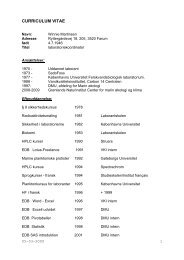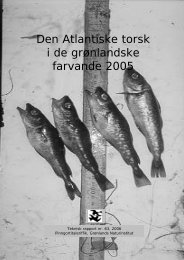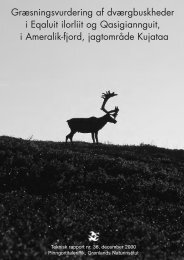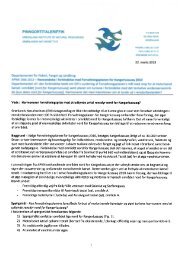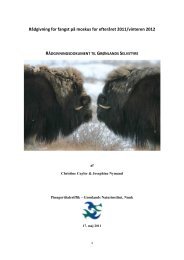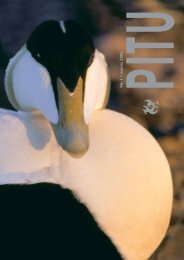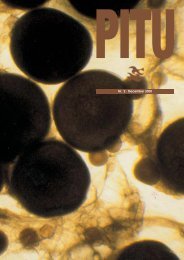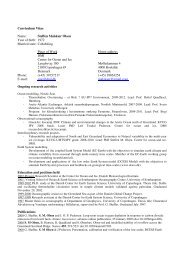Migration and breeding biology of Arctic terns in Greenland
Migration and breeding biology of Arctic terns in Greenland
Migration and breeding biology of Arctic terns in Greenland
You also want an ePaper? Increase the reach of your titles
YUMPU automatically turns print PDFs into web optimized ePapers that Google loves.
Figure 4. Growth <strong>of</strong> <strong>Arctic</strong> tern<br />
chicks <strong>in</strong> 2005 at Kitsissunnguit,<br />
Disko Bay, West Greenl<strong>and</strong>. The<br />
fi gure shows average mass <strong>and</strong><br />
SE bars <strong>in</strong> chicks (15.2 daily<br />
measurements on average) from<br />
hatch<strong>in</strong>g to fl edgl<strong>in</strong>g. In the l<strong>in</strong>ear<br />
growth period (4-14 days) the<br />
equation describ<strong>in</strong>g daily mass<br />
<strong>in</strong>crease is <strong>in</strong>serted.<br />
22<br />
Table 2. Hatch<strong>in</strong>g success (proportion <strong>of</strong> eggs hatched), fl edg<strong>in</strong>g success (proportion <strong>of</strong><br />
chicks fl edged) <strong>and</strong> productivity (number <strong>of</strong> fl edgl<strong>in</strong>gs per nest) from Kitsissunnguit, western<br />
Greenl<strong>and</strong>, 2002-2006, <strong>and</strong> S<strong>and</strong> Isl<strong>and</strong>, northeast Greenl<strong>and</strong>, 2007-2008.<br />
Location Year Hatch<strong>in</strong>g success a Fledg<strong>in</strong>g success a Productivity (SD) n<br />
Kitsissunnguit 2002 0.90 (n=65) 0.37 (n=59) 0.56 (0.50) n=39<br />
Kitsissunnguit 2003 0.93 (n=54) 0.58b (n=50) 0.58b (0.319) n=24<br />
Kitsissunnguit 2004 * * *<br />
Kitsissunnguit 2005 0.91 (n=46) 0.38 (n=42) 0.75 (0.433) n=20<br />
Kitsissunnguit 2006 0.93 (n=73) 0.43 (n=68) 0.85 (0.595) n=46<br />
S<strong>and</strong> Isl<strong>and</strong> 2007 * * *<br />
S<strong>and</strong> Isl<strong>and</strong> 2008 0.84 (n=85) 0.69 (n=71) 1.04 (0.771) n=48<br />
aProductivity <strong>and</strong> Hatch<strong>in</strong>g/Fledg<strong>in</strong>g success is not necessary based on measurements <strong>in</strong> the same eggs/nests.<br />
bIn 2003 chicks could only be followed to the age <strong>of</strong> 7-15 days old. Values <strong>of</strong> fl edg<strong>in</strong>g success <strong>and</strong> productivity<br />
may not be representative.<br />
* = no data on chick production <strong>in</strong> 2004 <strong>and</strong> 2007.<br />
more, the year with the second highest recorded chick production (2005)<br />
was also the season with the second highest proportion <strong>of</strong> 3-egg clutches.<br />
Although the few data po<strong>in</strong>ts <strong>in</strong> the study may not be suffi cient to test if<br />
<strong>Arctic</strong> <strong>terns</strong> are able to adjust their clutch size to food availability <strong>in</strong> the<br />
current <strong>breed<strong>in</strong>g</strong> season (Suddaby <strong>and</strong> Ratcliffe 1997, Kilpi et al. 1992), the<br />
results suggest that this may <strong>in</strong> fact the case.<br />
1.12 Growth rate <strong>and</strong> chick survival<br />
Dur<strong>in</strong>g the course <strong>of</strong> fi eldwork, estimates <strong>of</strong> hatch<strong>in</strong>g success, chick<br />
growth <strong>and</strong> chick survival were obta<strong>in</strong>ed. <strong>Arctic</strong> tern chicks becomes agile<br />
<strong>and</strong> mobile after less than two days <strong>and</strong> will immediately start runn<strong>in</strong>g<br />
away from the nest site if a l<strong>and</strong> predator (humans <strong>in</strong>cluded) approaches<br />
(Bianki <strong>and</strong> Isaksen 2000). In order to obta<strong>in</strong> consistent daily measurements<br />
<strong>of</strong> chick growth <strong>and</strong> survival, a small enclosure made from chicken<br />
wire was set up around <strong>Arctic</strong> tern nests at the study site. This method has<br />
previously been applied (Monaghan et al. 1989 a, b) <strong>in</strong> <strong>Arctic</strong> tern studies,<br />
<strong>and</strong> the birds adapt well to the enclosure after a short habituation<br />
period. Nests were found dur<strong>in</strong>g the <strong>in</strong>cubation period <strong>and</strong> the nest area<br />
was enclosed prior to hatch<strong>in</strong>g. As l<strong>and</strong> predators were absent from the<br />
study sites dur<strong>in</strong>g the chick rear<strong>in</strong>g period, <strong>and</strong> the nest area could easy be<br />
approached from the air, it is unlikely that the enclosures <strong>in</strong>duced biased<br />
estimates <strong>of</strong> the level <strong>of</strong> predation.<br />
Mass (g)<br />
120<br />
100<br />
80<br />
60<br />
40<br />
20<br />
0<br />
0 5 10 15 20 25 30<br />
Chick age (days)<br />
y = 5.558x – 3.6022<br />
R 2 = 0.9568





